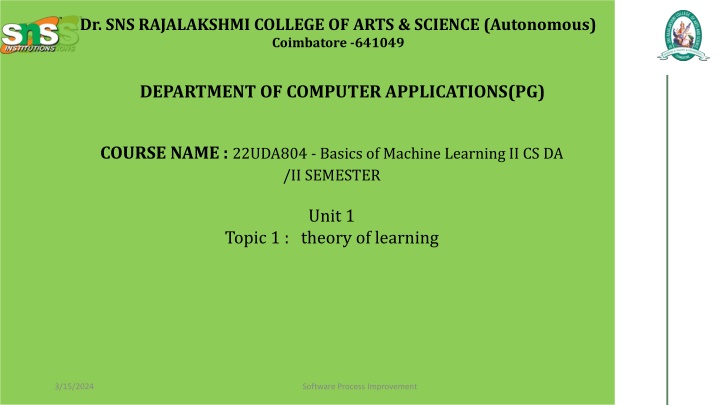
Exploring Theory of Learning in Machine Learning and AI
Understanding the theory of learning in machine learning and artificial intelligence involves formal frameworks and mathematical principles that explain how learning systems improve based on data, experience, or feedback. It encompasses components like tasks, environments, hypothesis spaces, data, and feedback to enhance performance in various learning paradigms. Dive into the general framework of learning, key concepts like supervised learning theory, generalization, and preventing overfitting vs. underfitting for effective machine learning practices.
Download Presentation

Please find below an Image/Link to download the presentation.
The content on the website is provided AS IS for your information and personal use only. It may not be sold, licensed, or shared on other websites without obtaining consent from the author. If you encounter any issues during the download, it is possible that the publisher has removed the file from their server.
You are allowed to download the files provided on this website for personal or commercial use, subject to the condition that they are used lawfully. All files are the property of their respective owners.
The content on the website is provided AS IS for your information and personal use only. It may not be sold, licensed, or shared on other websites without obtaining consent from the author.
E N D
Presentation Transcript
Dr. SNS RAJALAKSHMI COLLEGE OF ARTS & SCIENCE (Autonomous) Coimbatore -641049 DEPARTMENT OF COMPUTER APPLICATIONS(PG) COURSE NAME : 22UDA804 - Basics of Machine Learning II CS DA /II SEMESTER Unit 1 Topic 1 : theory of learning 3/15/2024 Software Process Improvement
theory of learning Theory of Learning in Machine Learning & Artificial Intelligence The theory of learning refers to the formal frameworks and mathematical principles that explain how learning systems (like humans, machines, or artificial agents) improve their performance based on data, experience, or feedback. It underpins various learning paradigms such as supervised, unsupervised, reinforcement, and semi-supervised learning. Here s a breakdown of the theory of learning with a focus on machine learning grouping and grading
theory of learning 1. General Framework of Learning In the context of machine learning, learning is about making decisions, predictions, or actions based on past experiences or data. The learning process generally consists of the following components: Task: The objective or goal the learning system is trying to achieve (e.g., classify images, predict stock prices). Environment: The domain or problem in which learning occurs (e.g., healthcare, gaming, finance). Hypothesis Space: The set of all possible models or hypotheses that can be used to map inputs to outputs. grouping and grading
theory of learning Data: The information (features, labels, experiences) the system uses to learn. Feedback: The information (like labels, rewards, or penalties) the system receives to improve its performance. grouping and grading
theory of learning Data: The information (features, labels, experiences) the system uses to learn. Feedback: The information (like labels, rewards, or penalties) the system receives to improve its performance. grouping and grading
theory of learning A. Supervised Learning Theory Supervised learning focuses on learning a function from labeled data. The goal is to find a hypothesis h that maps the input data ? X to the correct output ? Y. grouping and grading
theory of learning Key Concepts: Generalization: The ability of a model to perform well on unseen data. A model should not just memorize the training data but generalize from it. Overfitting vs Underfitting: Overfitting: The model fits the training data too well, capturing noise and leading to poor generalization. Underfitting: The model fails to capture the underlying patterns in the data. Bias-Variance Tradeoff: The tradeoff between how simple a model is (bias) and how sensitive it is to variations in data (variance). grouping and grading
theory of learning Learning Bound: PAC Learning (Probably Approximately Correct): A framework that formalizes learning in a way that ensures the learner will get a good approximation of the target function with high probability. grouping and grading
theory of learning B. Unsupervised Learning Theory Unsupervised learning involves learning from unlabeled data and discovering patterns or structures within it (e.g., clustering, dimensionality reduction). Key Concepts: Clustering: Grouping similar data points together based on shared features. Dimensionality Reduction: Reducing the number of features while maintaining essential information (e.g., PCA). Manifold Learning: The idea that high-dimensional data points often lie on a lower- dimensional manifold, which unsupervised learning tries to identify. grouping and grading
theory of learning C. Reinforcement Learning (RL) Theory Reinforcement learning focuses on learning how to act in an environment to maximize cumulative reward over time. The agent learns through interactions with the environment, receiving feedback in the form of rewards and penalties. Key Concepts: Markov Decision Process (MDP): A formal model used in RL, consisting of states, actions, rewards, and transitions. Policy: A mapping from states to actions. The goal is to learn an optimal policy that maximizes rewards over time. Value Function: The expected return (reward) an agent can obtain from a given state or action. Bellman Equation: A recursive relationship used to compute the value function or optimal policy in RL. grouping and grading
theory of learning C. Reinforcement Learning (RL) Theory Reinforcement learning focuses on learning how to act in an environment to maximize cumulative reward over time. The agent learns through interactions with the environment, receiving feedback in the form of rewards and penalties. Key Concepts: Markov Decision Process (MDP): A formal model used in RL, consisting of states, actions, rewards, and transitions. Policy: A mapping from states to actions. The goal is to learn an optimal policy that maximizes rewards over time. Value Function: The expected return (reward) an agent can obtain from a given state or action. Bellman Equation: A recursive relationship used to compute the value function or optimal policy in RL. grouping and grading
